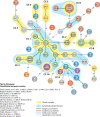The changing epidemiology of Clostridium difficile infections
- PMID: 20610822
- PMCID: PMC2901659
- DOI: 10.1128/CMR.00082-09
The changing epidemiology of Clostridium difficile infections
Abstract
The epidemiology of Clostridium difficile infection (CDI) has changed dramatically during this millennium. Infection rates have increased markedly in most countries with detailed surveillance data. There have been clear changes in the clinical presentation, response to treatment, and outcome of CDI. These changes have been driven to a major degree by the emergence and epidemic spread of a novel strain, known as PCR ribotype 027 (sometimes referred to as BI/NAP1/027). We review the evidence for the changing epidemiology, clinical virulence and outcome of treatment of CDI, and the similarities and differences between data from various countries and continents. Community-acquired CDI has also emerged, although the evidence for this as a distinct new entity is less clear. There are new data on the etiology of and potential risk factors for CDI; controversial issues include specific antimicrobial agents, gastric acid suppressants, potential animal and food sources of C. difficile, and the effect of the use of alcohol-based hand hygiene agents.
Figures

References
-
- Al-Nassir, W. N., A. K. Sethi, M. M. Riggs, G. S. Bobulsky, R. L. P. Jump, and C. J. Donskey. 2008. A comparison of clinical and microbiologic response to treatment of Clostridium difficile-associated disease with metronidazole and vancomycin. Clin. Infect. Dis. 47:56-62. - PubMed
-
- al Saif, N., and J. S. Brazier. 1996. The distribution of Clostridium difficile in the environment of South Wales. J. Med. Microbiol. 45:133-137. - PubMed
-
- Alston, W. K., and J. W. Ahern. 2004. Increase in the rate of nosocomial Clostridium difficile-associated diarrhoea during shortages of piperacillin-tazobactam and piperacillin. J. Antimicrob. Chemother. 53:549-550. - PubMed
-
- Alvarez-Perez, S., J. L. Blanco, E. Bouza, P. Alba, X. Gibert, J. Maldonado, and M. E. Garcia. 2009. Prevalence of Clostridium difficile in diarrhoeic and non-diarrhoeic piglets. Vet. Microbiol. 137:302-305. - PubMed
-
- Arabi, Y., F. Dimock, D. W. Burdon, J. Alexander-Williams, and M. R. Keighley. 1979. Influence of neomycin and metronidazole on colonic microflora of volunteers. J. Antimicrob. Chemother. 5:531-537. - PubMed
Publication types
MeSH terms
LinkOut - more resources
Full Text Sources
Other Literature Sources

